(单词翻译:单击)
Most prehistoric creatures were terrifying, and every day we're glad they so politely died off those millions of years ago to bequeath us this awesome planet. But prehistoric animals weren't always nightmarish. Sometimes, they swapped terror for the weird and goofy.
大多数史前生物都很令人恐惧,好在让人高兴的是,它们在数百万年前相继死去,客气地把这颗令人敬畏的星球让给了我们。不过,史前生物也并不总是那么恐怖,有时候,它们怪异呆萌的一面会取代它们可怕的那一面。
10.Dinosaur Eggs Were Colorful
10.五颜六色的恐龙蛋
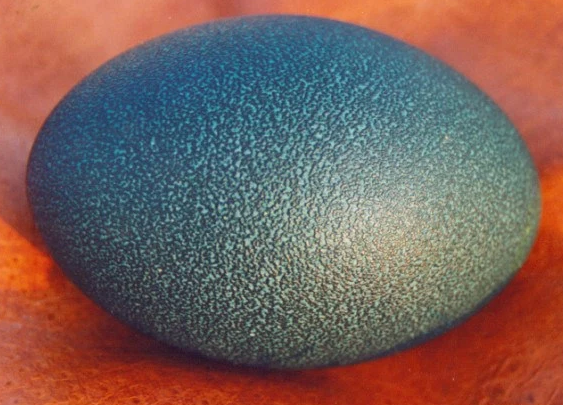
Dinosaurs were a lot more colorful than we give them credit for in horror movies. You probably already know that some dinos sported flamboyantly hued feathers, but now we have strong evidence that even their eggs looked fabulous.
恐龙的颜色远比我们在恐怖电影中赋予它们的更丰富。你可能已经知道,一些恐龙会卖弄色彩艳丽的羽毛,但我们现在已有真凭实据,可以证明连恐龙蛋都十分精妙。
Oviraptor eggs, for example, were a soothing greenish-blue, according to a 67-million-year-old clutch of eggs found in China. Most fossilized dinosaur eggs have been stained dark as a result of minerals seeping into the shell over time. However, the eggs in this particular clutch were pale and relatively untainted, allowing scientists to identify the pigments biliverdin and protoporphyrin. These are the same pigments that produce the beautiful colors in the eggs of emus and cassowaries—two really old birds, evolutionarily speaking. At first, it might seem like colored eggs would be easier for predators to spot, but it's actually just the opposite. Many dinosaurs kept their eggs in earthen, grassy nests, where a white egg would stand out like a sore thumb. But verdigris eggs would have blended in perfectly, allowing mama dinos to leave their eggs safely camouflaged while they sauntered off to catch a quick meal.
例如,根据一窝在中国发现且有6700万年历史的恐龙蛋来看,窃蛋龙的蛋的颜色是一种舒缓的蓝绿色。由于矿物会渗漏到蛋壳内,因此久而久之,大多数已成化石的恐龙蛋会被染成黑色。然而,这一窝蛋颜色较浅,且相对没有染污,科学家们可以鉴定出其中的胆绿素和原卟啉。这些色素也造就了鸸鹋蛋和食火鸡蛋的漂亮颜色--从进化的角度来说,鸸鹋和食火鸡都是古老的鸟类。起初,我们可能会觉得彩色的蛋更容易被食肉动物发现,但事实正好相反。许多恐龙会把它们的蛋放置在由土和草做成的窝里,这样,白色的蛋会异常显眼,但铜绿色的蛋会与之完美融合。当要外出猎食的时候,恐龙妈妈就可以放心地离开伪装得很安全的蛋。
9.Archaeopteryx Had Feathery Trousers
9.穿"毛裤"的始祖鸟
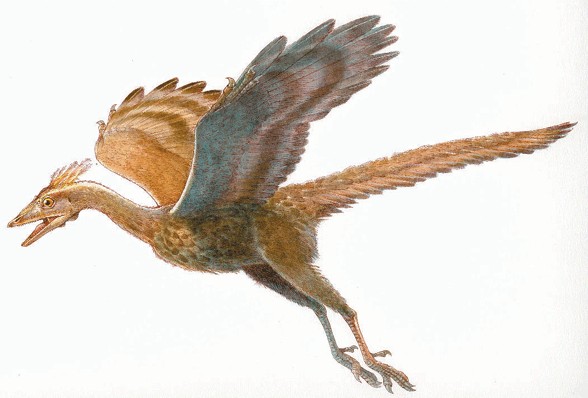
First discovered in Germany in 1861, Archaeopteryx is a milestone species because it represents the transition between dinosaurs and birds. Its teeth, claws, and beady eyes clearly identify it as a dinosaur, but its bird-like feathers show a clear link with modern avians as well.
于1861年在德国首次发现的始祖鸟是划时代的物种,因为它代表了恐龙与鸟之间的过渡。它的牙齿、爪子和明珠般的眼睛都清楚地表明它是恐龙,但它那如鸟一样的羽毛也说明它与现代鸟类有着明显的联系。
For a long time, paleontologists weren't sure whether Archaeopteryx had feathers all over its body or just on its wings. But recently, a surprisingly intact new fossil (a total of 11 have been found so far) revealed plumes of feathers running down its legs. Thanks to its thick feather-shafts, most scientists do think Archaeopteryx could fly, but the newly discovered leg feathers wouldn't have played a great role in that. Instead, the lower-body fluff might have served several other functions, including insulation and camouflage.It's also possible that the pennate feathers evolved for display. The feathers found lining Archaeopteryx's body are symmetrical. Which sounds great, but it's actually asymmetrical feathers that are perfect for flight. So, Archaeopteryx probably evolved feathers to entice mates or communicate, which were then gradually "recruited for aerodynamic functions."
在很长一段时间里,古生物学者都不能确定始祖鸟是全身都有毛还是只有翅膀有毛。但最近,一个完好无损的新化石(目前共发现了11个)显示,它的腿上都长有羽毛。由于它的羽轴粗大,大部分科学家都认为始祖鸟会飞,但最新发现的腿部羽毛可能对它的飞翔并不起多大作用。相反,下肢的绒毛可能具有保温和伪装等其他功能。翼上的羽毛也可能进化为炫耀的工具。始祖鸟身上内层的羽毛是对称的,这听起来很不错,但其实非对称的羽毛才最适合飞翔。所以,始祖鸟进化出羽毛可能是为了吸引配偶或交流,之后才渐渐地"有了飞行功能"。
8.Atopodentatus Unicus Had Vertical Zipper Teeth
8.独特须齿龙的垂直梳状牙齿
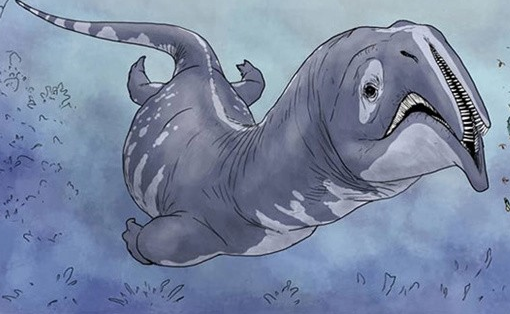
The time of the dinosaurs spawned some truly weird and horrific mouths, but Atopodentatus unicus is in a class of its own. Its mouth is so bizarre, it was actually named after it—Atopodentatus roughly translates as "weird teeth."
恐龙时代出现了一些千奇百怪的恐怖大嘴,而独特须齿龙则单独属于一类。它的嘴巴相当古怪,它也因此得名--"Atopodentatus",大概可以翻译为"怪异的牙齿"。
Around 3 meters (9 ft) in length, Atopodentatus was equally comfortable on land or in the seas. Lacking the hydrodynamic advantage of other sea monsters, Atopodentatus made up for it with a mouth full of needles. But what's really weird is that some of those needle-like teeth were set vertically in its ugly face. In other words, its mouth looked just like a zipper. Not subscribing to the notion that less is more, Atopodentatus was also equipped with a relatively standard set of chompers spaced across a conventional lower and upper jaw. All in all, the terrifying marine reptile boasted about 400 hypodermic teeth spread across its multiple mandibles. Sadly, while that sounds fearsome, scientists believe Atopodentatus was a bottom feeder and used its vertical teeth as a filtering screen rather than a tool for terrorizing smaller creatures.
独特须齿龙长约3米(9英尺),在陆地和水里都行动自如。由于没有其他海洋巨兽所拥有的流体力学优势,独特须齿龙便用满口针齿进行弥补。但奇怪的是,有些针一样的牙齿竟然垂直长在它那张丑陋的脸上。换句话说,它的嘴巴看上去就是一个拉链。与"少即是多"的概念不同,独特须齿龙牙齿的配置相对标准,排列在上下颚之间。总而言之,这恐怖的海洋爬行动物有400根尖牙,插在它的上下颌上。可惜的是,尽管这听起来很吓人,但科学家认为独特须齿龙是生活在海洋底层的食腐动物,垂直的牙齿是它用于捕食的滤网,而不是吓唬小型动物的工具。
7.The Crowned Triceratops
7.戴王冠的三角龙
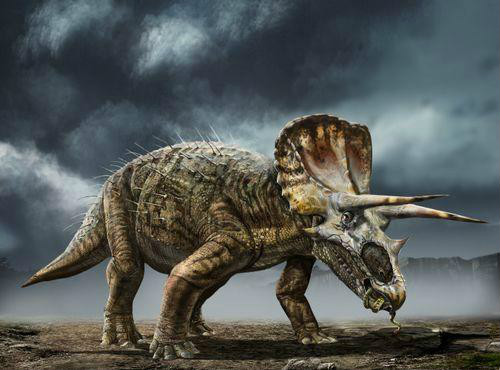
With three massive horns on its face and a shovel for a forehead, you can't get much cooler than a triceratops. Except the Cretaceous totally did, cranking out the closely related Regaliceratops peterhewsi, colloquially known as "Hellboy" for the small horns above its eyes.
脸上三只角,前额一把铲,没有比三角龙更酷的了。不过白垩纪时期可不一样,角龙种类十分丰富,诞生了这种"皇家角龙"--口头上被戏称为"地狱小子",因为它的眼睛上方长有一对角。
Regaliceratops translates to "royal horned face," while the creature's surname honors Peter Hews, the amateur fossil hunter who first noticed its ancient remains. Hews made his serendipitous discovery when he spotted a horn sticking out of a riverbank in Alberta, Canada. The specimen was airlifted to a museum while still encased in its limestone prison, and scientists subsequently spent two and a half years slowly chipping it down to a more recognizable form. The regaliceratops is weird for two reasons. Firstly, its horns are seemingly anachronistic. The triceratops usually had large brow horns and a smaller nose horn, whereas the regaliceratops had short brow horns and a huge nose spike, just like a separate line of dinosaurs that died out two million years earlier. Secondly, its shield of a forehead isn't frilled, but edged with pointy extensions that gave it a crown-like appearance (hence the name).
"Regaliceratops"可译为"长有犄角的皇室脸",而它的姓"peterhewsi"则是为了纪念彼得·休斯--一名爱好寻找化石的业余人士,是他最先发现了皇家角龙的遗骸。休斯在加拿大艾伯塔省的一处河岸边看见一只角露在外面,随后有了这次偶然的发现。化石被囚在石灰岩里空运到了一家博物馆,随后,科学家花了两年半的时间慢慢一点一点地将其更加清晰地呈现出来。皇家角龙有两大怪异的地方。首先,它的角似乎并不属于它那个时代。三角龙一般长有大型额角和小一点的鼻角,而皇家角龙额角很短,鼻角巨大,就像属于一种200多万年前就已经灭绝了的恐龙种族。其次,它前额的头盾没有褶皱,却延展开一圈尖锐的边缘,看起来就像戴了一顶皇冠(因此得名)。
6.Synapsids Push Back The Nocturnal Timeline
6.下孔类动物将夜行性动物出现的年代提前
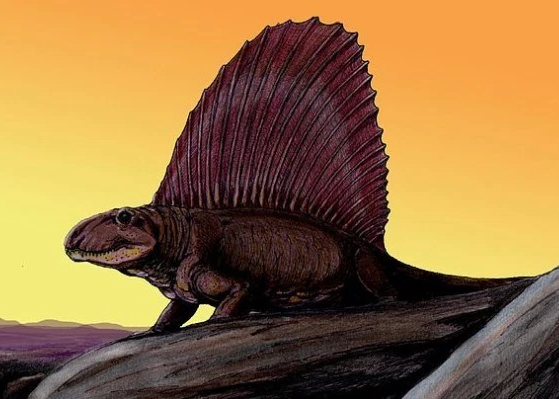
Around 300 million years ago, before even dinosaurs showed up, Earth teemed with synapsids: prototypical mammals that bore a superficial resemblance to lizards. These odd mammal precursors lived 100 million years before our small furry ancestors scurried underneath dinosaur noses. And, according to their fossils, they were nocturnal.
约3亿年以前,在恐龙出现之前,地球上都是下孔类动物:即一种外表与蜥蜴相似的典型哺乳动物。在这种奇特的哺乳动物祖先出现的一亿年后,才有了我们那些小型的、长有毛皮、在恐龙脚下落荒而逃的祖先们。根据已发现的化石,我们可以看出,它们还是夜行动物。
Researchers usually work out whether a species was active during the day or night by looking at eye size. Large eyes are indicative of a nocturnal lifestyle, whereas smaller eyes indicate activity during the day. Obviously, eyes don't survive the fossilization process, but a bony ring that forms around the eye socket is usually a good indicator of size. And the bony rings around synapsid eyes indicate that they mostly operated at night, which paleontologists found puzzling.Previously, the conventional wisdom held that the earliest mammals became nocturnal to avoid dinosaurian detection. But the night-owl synapsids show that nocturnal behaviors evolved long before dinosaurs were around to worry about. In fact, even apex predator synapsids like the massive, sail-backed dimetrodons were nocturnal, suggesting the behavior did not evolve as a defensive strategy at all.
研究学者们经常会通过眼形的大小来判断某个物种是白天活动还是夜间活动。大眼睛表明了夜间活动的生活方式,反之,小眼睛表明了白天活动的生活方式。显然,眼睛没有在石化过程中存留下来,但通常情况下,眼眶周围的骨轮是眼睛大小的标志。令古生物学者不解的是,从下孔类动物眼睛周围的骨轮可以看出,这些动物大多于夜晚行动。之前的传统观点认为,早期的哺乳动物为了躲避恐龙而成为夜行动物。但是作为夜猫子的下孔类动物告诉我们,这种夜行行为产生时,恐龙还没有成为它们的威胁。事实上,即使是大型帆状异齿龙这种处在食物链顶端的下孔类动物也是夜间活动,这就意味着夜行并不是一种防卫策略。
审校:赵倩 编辑:旭旭 来源:前十网


